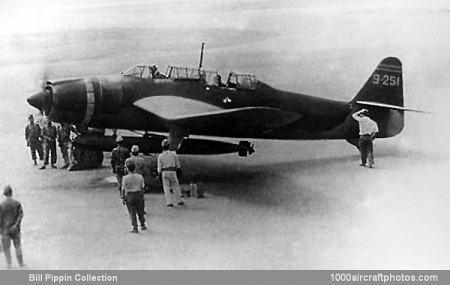The requirements for this aircraft included: (1) offensive load, two 551 lb (250 kg) bombs or six 132 lb (60 kg) bombs carried internally or one 1,764 lb (800 kg) torpedo carried externally; (2) defensive armament, two forward-firing 0.787 in (20 mm) cannon and one flexible 0.511 in (13 mm) machine gun; (3) maximum speed, 354 mph (570 kmh); (4) normal range, 1,151 mls (1,852 km) and maximum range, 2,071 mls (3,334 km); and (5) manoeuvrability equal to that of the Mitsubishi A6M Carrier Fighter. As the aircraft was intended to operate from a new class of aircraft carriers the traditional restriction on aircraft length to 36 ft 1.1 in (11 m) - stemming from the size of deck elevators on the older aircraft carriers - was waived.
To meet the payload, range and speed requirements a powerful engine had to be selected and Aichi were instructed to use a Nakajima Homare eighteen-cylinder radial, a power plant which was then favored by the Navy to become their standard aircraft engine in the 1,800 hp to 2,200 hp class. The need to select a mid-wing configuration to provide space in the fuselage for a ventral bomb-bay combined with the necessity to provide adequate clearance for the 11 ft 5.8 in (3.5 m) diameter four-blade propeller made it necessary to select an inverted gull wing to reduce the length of the landing gear legs. The wings were also fitted with drooping ailerons, which could be deflected 10° to serve as auxiliary flaps, and dive brakes were mounted on the undersurface ahead of the flaps between the fuselage and ailerons. For carrier stowage the wings folded hydraulically upwards outboard of the flaps.
Designated AM-23 by its manufacturers and Navy Experimental 16-Shi Carrier Attack Bomber (B7A1) by the Japanese Navy, the first prototype was completed in May 1942. As the aircraft was the first to be powered by the still experimental 1,800 hp Homare 11 engine, the flight trial program was constantly interrupted by engine teething troubles, but when the Homare 11 performed smoothly the B7A1 demonstrated sparkling performance and excellent handling characteristics. A total of nine Homare 11 powered B7A1 prototypes were built and were progressively modified to eradicate minor airframe and equipment problems. In April 1944 an improved engine version, the 1,825 hp Homare 12, became available and powered by this engine the aircraft was finally placed in production as the Navy Carrier Attack Bomber Ryusei.
Assembly lines for the Homare 12 powered B7A2 were set up by Aichi Kokuki K.K. at Funakata and the 21st Naval Air Arsenal (Dai-Nijuichi Kaigun Kokusho) at Omura, but production was slow in gaining tempo despite the fact that the B7A was easier to build than the much smaller Yokosuka D4Y which Aichi had been building for many years. Initial production aircraft retained the flexible rear-firing 0.312 in (7.92 mm) Type 1 machine gun but late production B7A2s mounted a 0.511 in (13 mm) Type 2 machine gun in its place. Production of the B7A2 by Aichi was finally brought to a standstill when the Funakata plant was destroyed by the earthquake which, in May 1945, rocked the Tokai district. However, this no longer affected the outcome of the war because the Japanese Navy had lost their carrier fleet and the small number of B7A2s (code name Grace) built saw limited service from land bases with the Yokosuka and 752nd Kokutais.
One B7A2 was experimentally fitted with a 2,000 hp Nakajima Homare 23 intended for future production aircraft but because of the earthquake the projected B7A3 Ryusei Kai powered by a 2,200 hp Mitsubishi MK9A was not realized. Production totaled 114 B7As, comprising 9 B7A1 prototypes and 80 B7A2 production aircraft built by Aichi, and 25 B7A2 production aircraft built by Dai-Nijuichi Kaigun Kokusho at Omura (Sasebo).
Description: Single-engined carrier-borne torpedo and dive-bomber. All-metal construction with fabric covered control surfaces.
Accommodation: Crew of two in tandem enclosed cockpits.
Power plant:
On B7A1 prototypes: one Nakajima NK9B Homare 11 eighteen-cylinder air-cooled radial, rated at 1,800 hp for take off, 1,440 hp at 5,905 ft (1,800 m) and 1,560 hp at 20,997 ft (6,400 m), driving a constant-speed four-blade metal propeller.
On B7A2: one Nakajima NK9C Homare 12 eighteen-cylinder air-cooled radial, rated at 1,825 hp for take off, 1,670 hp at 7,875 ft (2,400 m) and 1,560 hp at 21,489 ft (6,550 m), driving a constant-speed four-blade metal propeller.
On single experimental B7A2: one Nakajima NK9H-S Homare 23 eighteen-cylinder air-cooled radial, rated at 2,000 hp for take off and 1,570 hp at 22,474 ft (6,850 m), driving a constant-speed four-blade metal propeller.
On B7A3: one Mitsubishi MK9A eighteen-cylinder air-cooled radial, rated at 2,200 hp for take off, 2,070 hp at 3,281 ft (1,000 m) and 1,930 hp at 16,404 ft (5,000 m), driving a constant-speed four-blade metal propeller.
Armament:
On B7A1 and early production B7A2: two wing-mounted 0.787 in (20 mm) Type 99 Model 2 cannon and one flexible rear-firing 0.312 in (7.92 mm) Type 1 machine gun.
On late production B7A2: two wing-mounted 0.787 in (20 mm) Type 99 Model 2 cannon and one flexible rear-firing 0.511 in (13 mm) Type 2 machine gun.
Bomb-load: One 1,764 lb (800 kg) torpedo or up to 1,764 lb (800 kg) of bombs.
The following data relate to the B7A2.
